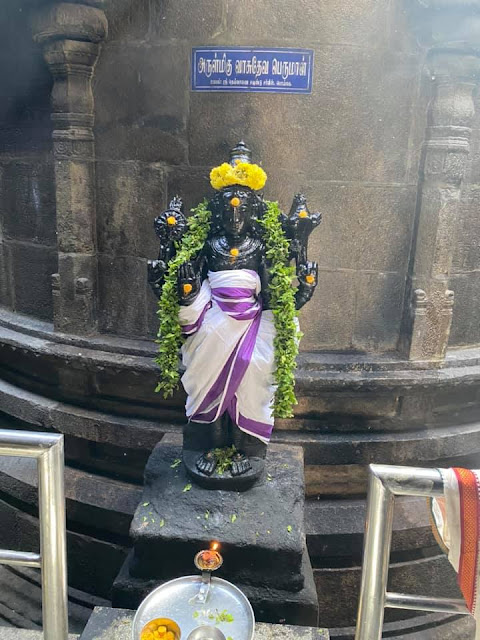Moolavar: Sri Margabandeeswarar
Amman: Sri Maragadhambikai
The history goes like this- Once Brahmma had to bear the effect of speaking a lie, though he did not really see the head of Lord Shiva in Tiruvannamalai, unwilling to admit the failure, he used a flower (Thazhamboo) that fell from the head of Shiva and said that it was evidence of his seeing the head of the Lord. So Lord Shiva did not want to give darshan to Brahmma in His real form and Brahamma was born to a priest in the temple named Shiva Sharman. After the death of the priest, he succeeded his father to serve the Lord.
After worshipping Swarna Ganapathi in the temple, Shiva Sharman came to the Lord for His abishek with the Tirumanjanam pot, but could not touch the head of the Lord as he was a boy. Merciful Lord bent His head to help the boy and acknowledged his services. Hence the Lord is found slightly bent towards esanya or northeast. is.
The presiding deity is a swayambumurthi in a leaning form. The rays of Sun fall on the Lord in the month of Panguni (March- April). Palm tree is the sthala Vruksha of the temple which is in the inner corridor – prakara of the temple. This has a peculiar character of giving the fruits in black in a year and white the following year. The importance of the temple lies in the Rudraksha roof above the Sanctum sanctorum. Virinjipuram has also the reputation of being sung by renowned Vedic scholar and Shiva devotee, Sri Appayya Dikshithar.
There are 1008 shivalingams in this temple. It is said that off the main 108 shivalingams 18 of them are very special, and this shivalingam is one of the 18 and a must see.
The temple is an outstanding example of Tamil architectural skill. The temple is noted for child boon prayer. It is the staunch faith of the devotees that taking the first bath in Palaru river followed by dips in Brahmma and Simha theerthas (tanks) and going round the deity ensures child boon. People also pray for timely marriages. Devotees also throng the temple for relief from the effects of witchcrafts occupying the family or the individual.
The temple is open from 6.00 a.m. to 11.00 and 4.00 p.m. to 8.00 p.m.























































